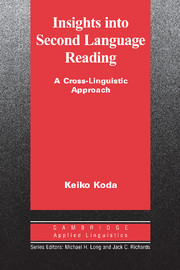Book contents
- Frontmatter
- Contents
- Tables and figures
- Series editors' preface
- Foreword
- Acknowledgments
- I THEORETICAL FOUNDATIONS
- II ESSENTIAL COMPONENTS
- 3 Word recognition
- 4 Vocabulary knowledge
- 5 Intraword awareness and word-knowledge development
- 6 Information integration in sentence processing
- 7 Discourse processing
- 8 Text structure and comprehension
- III LOOKING AT THE WHOLE
- IV THEORY INTO PRACTICE
- References
6 - Information integration in sentence processing
Published online by Cambridge University Press: 05 October 2012
- Frontmatter
- Contents
- Tables and figures
- Series editors' preface
- Foreword
- Acknowledgments
- I THEORETICAL FOUNDATIONS
- II ESSENTIAL COMPONENTS
- 3 Word recognition
- 4 Vocabulary knowledge
- 5 Intraword awareness and word-knowledge development
- 6 Information integration in sentence processing
- 7 Discourse processing
- 8 Text structure and comprehension
- III LOOKING AT THE WHOLE
- IV THEORY INTO PRACTICE
- References
Summary
The preceding chapters described the manner in which lexical information is learned, stored, and accessed during comprehension. Word identification, in itself, however, does not explain how meaning is constructed from visual input. Isolated words, for example, must be incrementally integrated into larger linguistic units – that is, phrases, clauses, and sentences – by incorporating their syntactic, semantic, and pragmatic information. Linguistic knowledge, therefore, is a major source of individual differences in sentence processing. Although texts vary considerably in their lexical and syntactic features, we have limited understanding of how the linguistic variables affect sentence comprehension. If some features have more impact on processing efficiency than others, we need to isolate them, disentangle their effects, and explore causal linkages with specific reading difficulties. Consequently, building on information extraction at the word level, this chapter explores information integration at the sentence level. After examining the relationship between linguistic variables and comprehension difficulty, by reviewing several models of sentence processing, it describes logical ways to compare processing procedures across typologically diverse languages. The implications of L1 research findings for L2 comprehension also are considered in a review of empirical studies on L2 sentence processing.
Linguistic complexity and comprehension difficulty
Linguistic determinants of text complexity
Whether systematicity exists in the relationship between syntactic features and comprehension problems has long received research attention. The resurrection of interest in the relationship has prompted major controversy between conventional views of text complexity and its automatic connection with reading difficulty.
- Type
- Chapter
- Information
- Insights into Second Language ReadingA Cross-Linguistic Approach, pp. 95 - 122Publisher: Cambridge University PressPrint publication year: 2005



